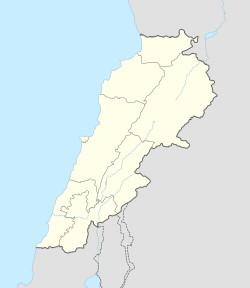Haouch Tall Safiyeh
In this article, we will explore the topic of Haouch Tall Safiyeh in depth, addressing its origins, development, and relevance today. Since its emergence, Haouch Tall Safiyeh has captured the interest of academics, specialists and the general public, sparking debates, reflections and advances in various fields. Over the years, Haouch Tall Safiyeh has proven to be a topic of great importance, both for its impact on society and for its influence on different areas of knowledge. Through this comprehensive analysis, we will seek to understand the significance of Haouch Tall Safiyeh and its role in a constantly changing world.
Haouch Tall Safiyeh
حوش تل صفية | |
|---|---|
Village | |
| Coordinates: 34°01′30″N 36°08′23″E / 34.02500°N 36.13972°E | |
| Country | |
| Governorate | Baalbek-Hermel Governorate |
| District | Baalbek District |
| Area | |
• Total | 1.95 sq mi (5.05 km2) |
| Elevation | 3,363 ft (1,025 m) |
| Population | |
• Total | 2,000 |
| Time zone | UTC+2 (EET) |
| • Summer (DST) | +3 |
حوش تل صفية | |
| Location | 3km southwest of Yaate near Baalbek |
|---|---|
| Region | Bekaa Valley |
| Type | Tell |
| History | |
| Cultures | Neolithic |
| Site notes | |
| Excavation dates | 1933, 1954, 1957, 1966 |
| Archaeologists | A. Jirku, A. Kuschke, Lorraine Copeland |
| Condition | Ruins |
| Public access | Yes |
Haouch Tall Safiyeh or Haouch Tal Safiya (حوش تل صفية) is a village and an archaeological site 3 km southwest of Yaate near Baalbek in Baalbek-Hermel Governorate. It dates at least to the Neolithic period.[1] The village is mostly Shiite, with 499 Shiite voters, 171 Maronites and 14 Sunnis.[2]
History
In 1838, Eli Smith noted Haush Tell Safiyeh as a Metawileh village in the Baalbek area.[3]
References
- ^ Université Saint-Joseph (Beirut; Lebanon) (1969). Mélanges de l'Université Saint-Joseph, p.82. Impr. catholique. Retrieved 25 March 2011.
- ^ "Haouch Tall Safiyeh | Drupal". www.libandata.org. Retrieved 2023-03-14.
- ^ Robinson, Edward; Smith, Eli (1841). Biblical researches in Palestine, Mount Sinai and Arabia Petraea : a journal of travels in the year 1838. Robarts - University of Toronto. Boston : Crocker. p. 145.

